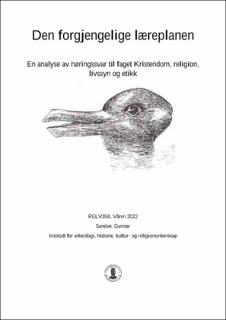| dc.contributor.author | Sandve, Gunnar | |
| dc.date.accessioned | 2022-06-25T00:24:26Z | |
| dc.date.available | 2022-06-25T00:24:26Z | |
| dc.date.issued | 2022-05-20 | |
| dc.date.submitted | 2022-06-17T22:00:26Z | |
| dc.identifier.uri | https://hdl.handle.net/11250/3000809 | |
| dc.description.abstract | I 2020 ble det innført en ny læreplan for faget Kristendom, religion, livssyn og etikk (KRLE) i norsk skole. Før den endelige læreplanen ble godkjent, gikk den gjennom en høringsprosess der kommuner, organisasjoner, universiteter, skoler og lærere fikk mulighet til å komme med innspill til forslaget til læreplan. Det kom inn totalt 317 svar fra de ulike høringsinstansene. Svarene ga et innblikk i hva grupper og enkeltpersoner ønsket at KRLE skulle inneholde. I denne oppgaven prøver jeg å sondere de ulike oppfatningene mellom og innenfor to av disse gruppene, nærmere bestemt mellom instansene «lærer/lektor/skoleansatte» på den ene siden, og «universiteter/høgskole», «private høgskoler» og « faggruppe / forskningsgruppe» på den andre. Etter å ha gjennomført en innholdsanalyse med kategoriene «åpenhet», «kristendom» og «verdensreligion» som tilnærming, kan det etter mitt syn dannes to dominerende diskurser på tvers av de to gruppene. På denne måten er høringen både en faglig forhandling om hva KRLE skal inneholde og en ideologisk ladet prosess. Disse diskursene diskuteres i forhold til Oddrun Marie Hovde Bråtens dimensjonsmodell, hvor jeg også foreslår at en annen dimensjon kan legges til, nemlig en temporal dimensjon. Slik sett formidler begge diskursene hva respondentene velger å huske fra fortiden, hva de tenker om nåtiden og hva de ønsker for fremtiden. | |
| dc.description.abstract | In 2020, a new curriculum for the subject Kristendom, religion, livssyn og etikk (KRLE) was introduced in Norwegian schools. Before the final curriculum was approved, it went through a consultation process in which municipalities, organizations, universities, schools and teachers had the opportunity to provide input to the proposed curriculum. A total of 317 responses were received from the various consultative bodies. The answers provided an insight into what groups and individuals wanted KRLE to contain. In this thesis I will try to probe the different perceptions between and within two of these groups, more specifically between the bodies «teacher / lecturer / school staff» on the one hand, and «universities / college», «private colleges» and «professional group / research group» on the other. After conducting a content analysis with the categories "openness", "Christianity" and "world religion" as approach, in my view, two dominant discourses apears across the two groups. In this way, the consultation is not only a negotiation concerning what the subject KRLE should contain, but also an ideologically charged process. These discourses are discussed in relation to Oddrun Marie Hovde Bråten's dimensional model, where I also suggest that another dimension can be added, namely a temporal dimension. In this sense, both discourses convey what the respondents choose to remember from the past, what they think about the present, and what they want for the future. | |
| dc.language.iso | nob | |
| dc.publisher | The University of Bergen | |
| dc.rights | Copyright the Author. All rights reserved | |
| dc.subject | læreplanteori | |
| dc.subject | læreplan | |
| dc.subject | Læreplan | |
| dc.subject | Fagfornyelsen | |
| dc.subject | skole og akademia | |
| dc.subject | høring | |
| dc.subject | verdensreligionsparadigmet | |
| dc.subject | KRLE | |
| dc.title | Den forgjengelige læreplanen – En analyse av høringssvar til faget Kristendom, religion, livssyn og etikk | |
| dc.title.alternative | The impermanent curriculum - An analysis of consultation responses to the subject Christianity, religion, philosophy and ethics | |
| dc.type | Master thesis | |
| dc.date.updated | 2022-06-17T22:00:26Z | |
| dc.rights.holder | Copyright the Author. All rights reserved | |
| dc.description.degree | Religionsvitenskap mastergradsoppgave | |
| dc.description.localcode | RELV350 | |
| dc.description.localcode | MAHF-RELV | |
| dc.description.localcode | MAHF-LÆHR | |
| dc.subject.nus | 714218 | |
| fs.subjectcode | RELV350 | |
| fs.unitcode | 11-22-0 | |
